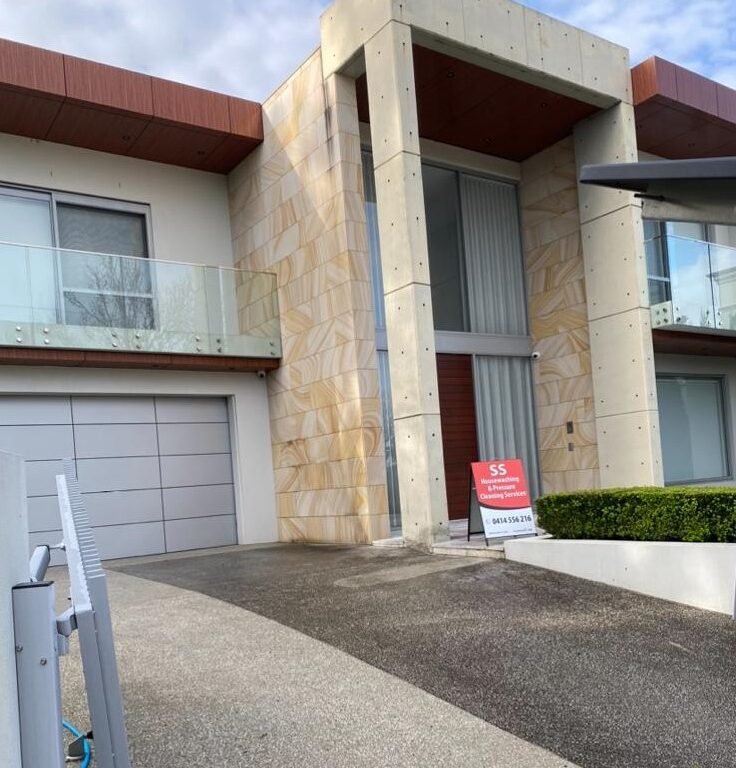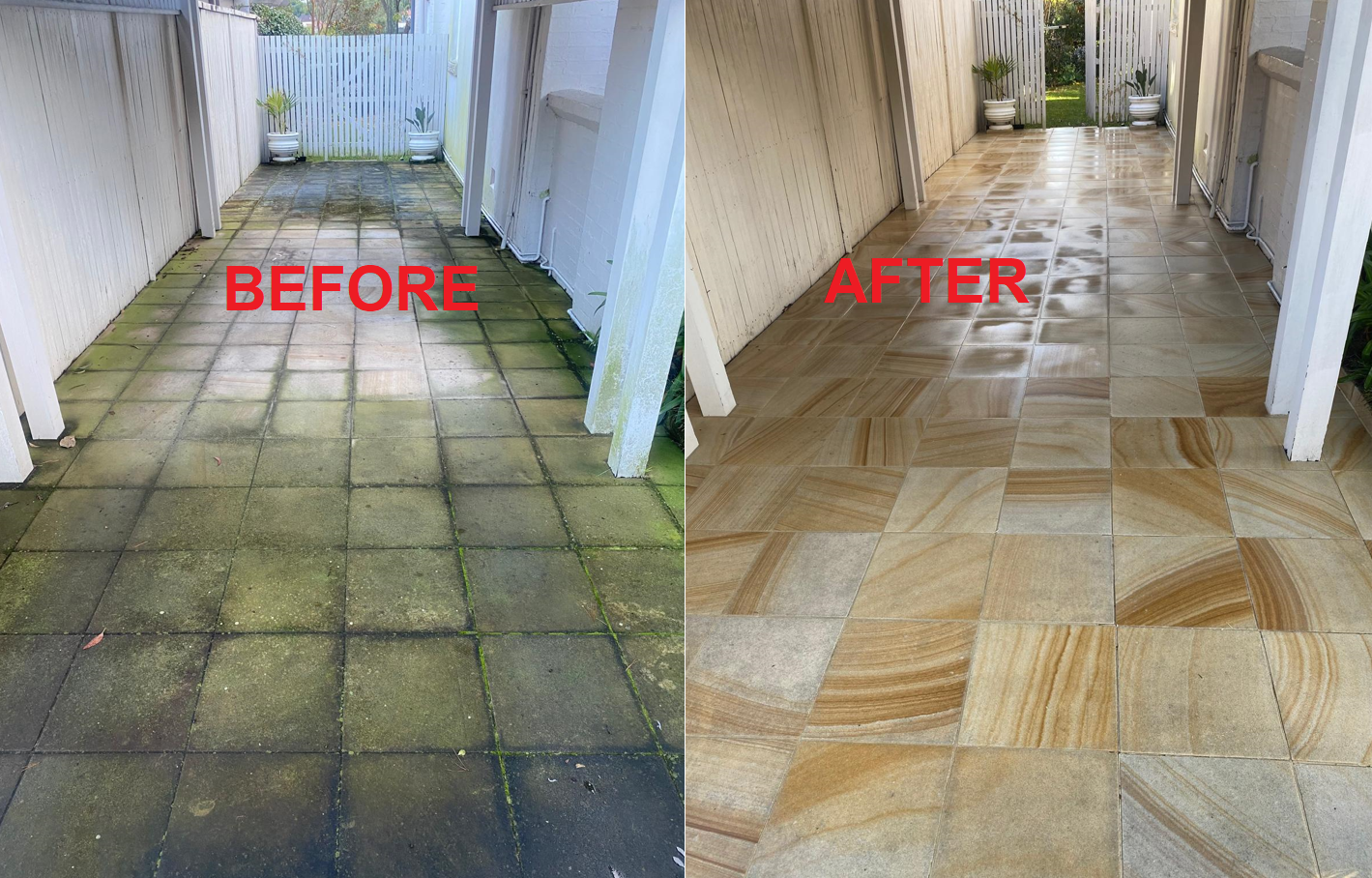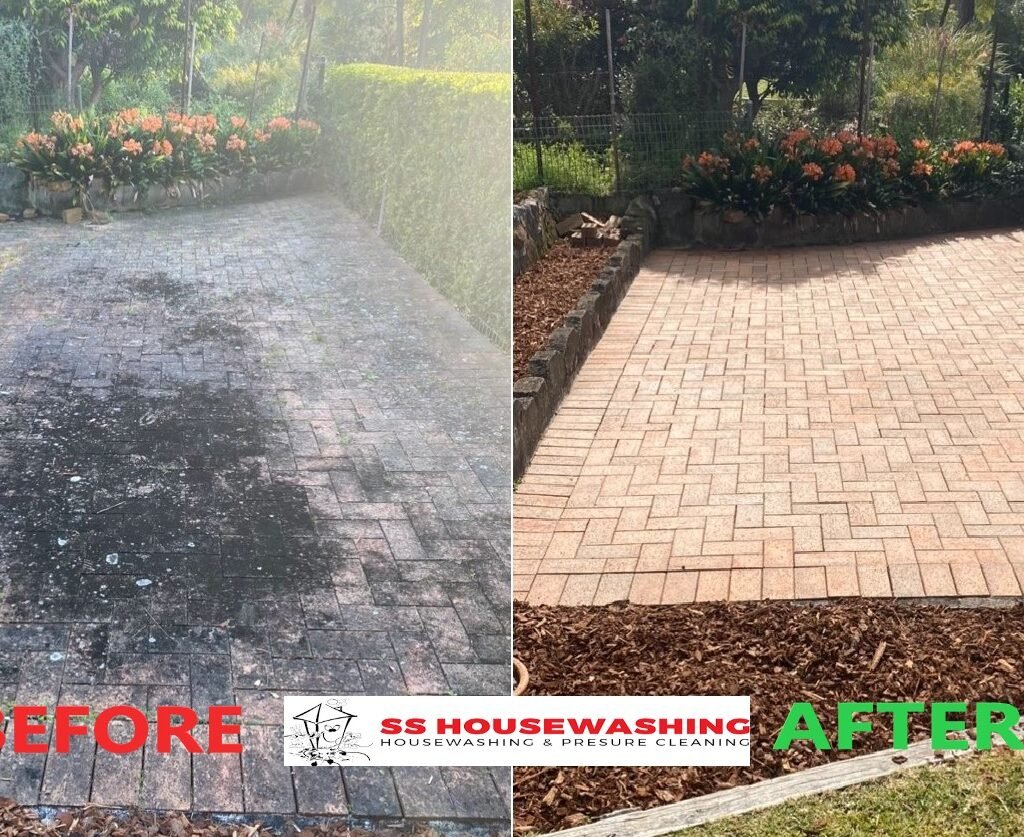Living in Sydney means enjoying beautiful beaches, vibrant city life, and some truly unique weather. From the humid, subtropical summers to the coastal sea spray, our climate is part of what makes this city special. However, these same elements can be incredibly harsh on your home’s exterior surfaces. Over time, that beautiful facade can become a breeding ground for mould, a canvas for grime, and a victim of corrosive salt. Ignoring these signs isn’t just an aesthetic issue; it can lead to permanent staining, costly repairs, and a significant drop in your property’s value. This article explores how Sydney’s specific weather patterns impact your home and why scheduling a regular, professional clean with SS House Washing and Pressure Washing Sydney isn’t just a luxury, it’s an essential part of home maintenance.
Understanding Sydney's Unique Climate Challenges
Sydney experiences a humid subtropical climate characterised by warm summers, mild winters, and significant rainfall throughout the year. This climate, combined with the city’s coastal location, creates specific challenges that directly impact your home’s exterior surfaces.
The Coastal Salt Air Factor
Living within proximity to Sydney Harbour and the Pacific Ocean means your home is constantly exposed to salt-laden air. This invisible threat penetrates every corner of your property, settling on walls, roofs, driveways, and outdoor furniture. Salt is highly corrosive and hygroscopic, meaning it attracts and retains moisture from the air, creating an environment where mould, mildew, and algae can flourish.
The salt particles carried by ocean breezes don’t just disappear after settling on your surfaces. Instead, they create a persistent layer that attracts dirt, pollution, and organic matter. Over time, this combination forms a stubborn coating that can permanently stain surfaces and accelerate deterioration if left untreated.

Humidity and Its Hidden Dangers
Sydney’s average humidity levels range from 60% to 70% throughout the year, with summer months often reaching higher levels. This persistent moisture in the air creates ideal conditions for biological growth on exterior surfaces. Mould, mildew, algae, and lichen thrive in these conditions, particularly on north-facing walls that receive less direct sunlight.
High humidity also means that surfaces take longer to dry completely after rain, allowing contaminants more time to penetrate porous materials like concrete, timber, and painted surfaces. This extended exposure period can lead to permanent staining and structural damage that becomes increasingly difficult and expensive to address.
Seasonal Weather Patterns and Their Impact
Each season in Sydney brings distinct challenges for your home’s exterior:
- Summer (December to February): Intense UV radiation, occasional severe storms, and high humidity levels work together to fade paint, crack sealants, and promote rapid biological growth. The combination of heat and moisture creates thermal expansion and contraction cycles that can damage exterior materials.
- Autumn (March to May): Falling leaves, increased rainfall, and fluctuating temperatures create debris buildup and moisture retention issues. Gutters become clogged, and organic matter accumulates in corners and crevices where it decomposes and stains surfaces.
- Winter (June to August): While milder than many climates, Sydney’s winter still brings consistent rainfall and reduced sunlight. These conditions slow the natural drying process and allow contaminants to remain on surfaces longer, increasing the likelihood of permanent staining and damage.
- Spring (September to November): Increased pollen, dust storms, and variable weather conditions can quickly dirty exterior surfaces. Spring is also when many organisms begin their most active growth phases, making it a critical time for preventive cleaning.
The Science Behind Weather-Related Exterior Damage
Understanding the scientific processes behind weather-related damage helps explain why regular pressure washing is not just cosmetic maintenance but essential protection for your investment.
When organic matter, moisture, and nutrients combine on your exterior surfaces, they create biofilms, complex communities of microorganisms that form protective matrices. These biofilms are incredibly resilient and provide a foundation for more visible growth like mould and algae.
Once established, biofilms actually change the surface properties of your exterior materials. They increase surface roughness, which traps more dirt and contaminants, creating a cycle of accelerating deterioration. The microorganisms within biofilms also produce acids and enzymes that can chemically break down paint, sealants, and even building materials themselves.
Biofilm Formation and Surface Degradation
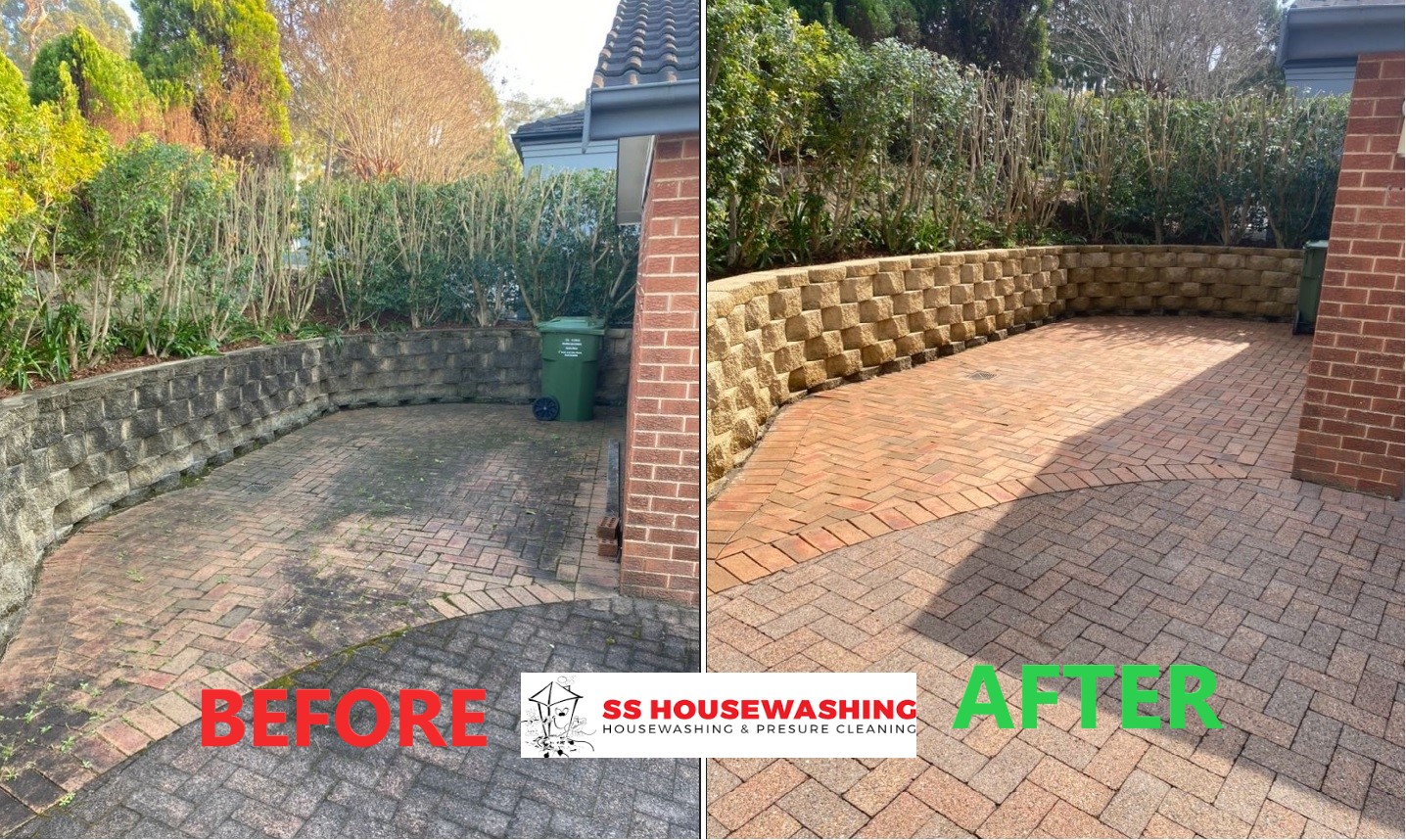
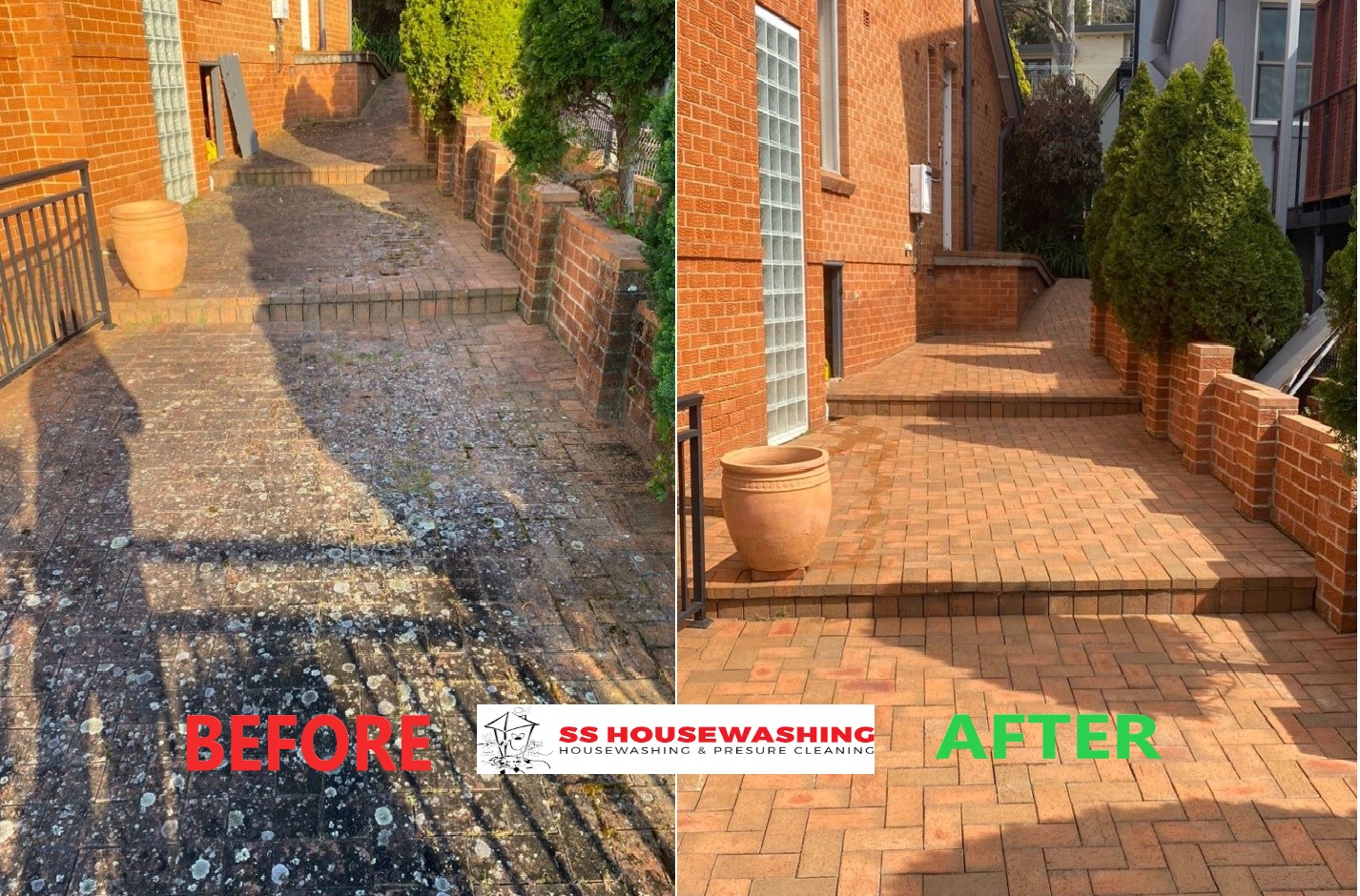
Thermal Cycling and Material Stress
Sydney’s temperature variations, while moderate, still create expansion and contraction cycles in building materials. When surfaces are dirty or contaminated, they absorb more heat during the day, leading to greater temperature differentials and more severe thermal stress.
Clean surfaces reflect more light and heat, reducing thermal cycling stress and extending the life of exterior materials. This is particularly important for painted surfaces, where thermal stress can cause cracking and peeling, leading to moisture infiltration and further damage.
Chemical Weathering and Pollution Impact
Sydney’s urban environment exposes your home to various airborne pollutants, including vehicle emissions, industrial particles, and dust. These contaminants don’t just sit on surfaces – they react chemically with building materials and accelerate weathering processes.
Acid rain, while less severe in Sydney than in some industrial cities, still occurs and can gradually dissolve limestone-based materials and etch metal surfaces. Regular pressure washing removes these accumulated chemicals before they can cause permanent damage.
Specific Areas of Your Home Most Affected by Sydney Weather
Different areas of your property face unique challenges based on their exposure, material composition, and function. Understanding these vulnerabilities helps prioritise maintenance efforts and identify when professional pressure washing is needed.
Exterior Walls and Siding
Your home’s walls bear the brunt of weather exposure, facing everything from driving rain to salt spray and UV radiation. Different wall materials respond differently to Sydney’s climate:
Brick and Masonry: While durable, brick and stone surfaces have porous qualities that allow salt, dirt, and biological matter to penetrate. The mortar joints are particularly vulnerable, as they can retain moisture and provide ideal conditions for plant growth and biological staining.
Rendered Surfaces: Cement render and similar materials are highly susceptible to biological growth, particularly on south-facing walls that receive less direct sunlight. Render can also develop efflorescence – white salt deposits that appear as moisture evaporates, leaving mineral deposits behind.
Weatherboard and Timber: Timber surfaces are particularly vulnerable to moisture retention and biological growth. Paint and stain protection can fail over time, allowing moisture to penetrate the wood and create ideal conditions for mould and rot.
Metal Cladding: While resistant to biological growth, metal surfaces can suffer from salt corrosion and chemical staining. Powder-coated surfaces can become chalky over time, reducing their protective properties.

Roofing Systems
Your roof faces the most severe weather exposure and plays a critical role in protecting your entire home. Sydney’s weather creates several roofing challenges:
Tile Roofs: Clay and concrete tiles can develop biological growth in their overlapping areas where moisture tends to collect. Lichen growth is particularly common and can actually damage tiles by growing into the material structure.
Metal Roofing: Colorbond and other metal roofing materials can suffer from salt corrosion and fading. Bird droppings and organic debris can create acidic conditions that accelerate corrosion processes.
Gutters and Downpipes: These critical drainage components face unique challenges from leaf litter, salt accumulation, and biological growth. Blocked or corroded gutters can lead to water damage throughout your property.
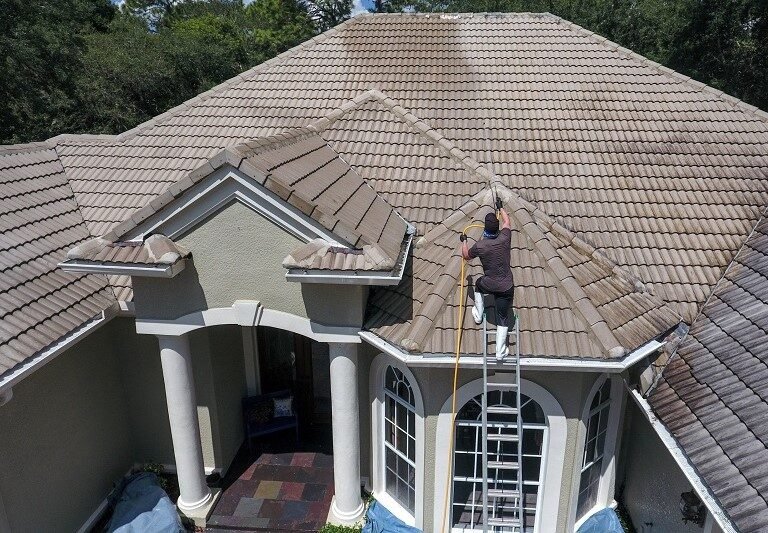
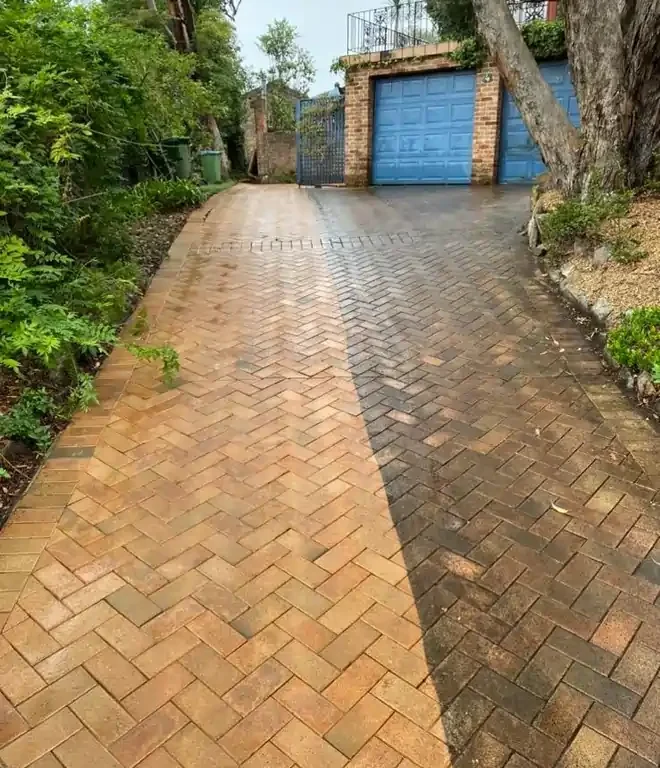
Driveways and Pathways
Horizontal surfaces like driveways and pathways face different challenges than vertical surfaces, as they deal with gravity-assisted staining and heavy foot or vehicle traffic:
Concrete Surfaces: Concrete driveways and paths are highly porous and readily absorb oils, organic stains, and salt. These contaminants can penetrate deeply, making removal increasingly difficult over time.
Paved Areas: Brick and stone paving can develop weed growth between joints, biological staining, and efflorescence. The joint materials are particularly vulnerable to weather damage and require regular maintenance.
Asphalt: While less common for residential driveways, asphalt surfaces can soften in Sydney’s summer heat and become more susceptible to staining and damage.
Outdoor Living Areas
Decks, pergolas, and outdoor entertainment areas face intensive use combined with weather exposure:
Timber Decking: Timber decks require regular maintenance to prevent moisture damage, biological growth, and UV degradation. Different timber species have varying resistance levels, but all benefit from regular cleaning and treatment.
Outdoor Furniture and Fixtures: Permanent outdoor installations like built-in BBQs, planters, and seating areas can harbor dirt and biological growth that affects both appearance and hygiene.
The True Cost of Neglecting Regular Pressure Washing
Many Sydney homeowners view pressure washing as an optional cosmetic service, but the reality is that regular cleaning is a critical maintenance investment that can save thousands of dollars in repair and replacement costs.
Immediate Aesthetic Impact
The most obvious cost of neglecting pressure washing is the aesthetic deterioration of your property. Dirty, stained exterior surfaces can dramatically reduce your home’s curb appeal and, consequently, its market value. Real estate professionals consistently report that clean, well-maintained exteriors can add thousands of dollars to property values and reduce time on the market.
Sydney’s competitive real estate market means that first impressions are crucial. A property with clean, bright exterior surfaces will always outperform a similar property with stained, dirty surfaces, regardless of other features and improvements.

Progressive Damage and Repair Costs

The longer contaminants remain on exterior surfaces, the more likely they are to cause permanent damage. What starts as surface staining can progress to structural issues that require expensive repairs:
Paint and Coating Failure: Biological growth and chemical contaminants can break down paint and protective coatings, leading to premature failure. Repainting costs can easily reach tens of thousands of dollars for a full exterior, far exceeding the cost of regular pressure washing maintenance.
Material Degradation: Persistent biological growth can actually digest building materials, particularly timber and some composite materials. Replacing damaged cladding or structural elements is exponentially more expensive than preventing the damage in the first place.
Moisture Infiltration: Failed exterior coatings allow moisture to penetrate building materials, leading to internal damage, insulation degradation, and potential health hazards from internal mould growth.
Health and Safety Considerations
Neglected exterior surfaces can pose health risks to your family and visitors. Biological growth on exterior surfaces can release spores and allergens that affect indoor air quality. Slippery growth on pathways and steps creates slip hazards that can lead to serious injuries and potential liability issues.
Energy Efficiency Impact
Dirty exterior surfaces absorb more heat than clean surfaces, increasing cooling costs during Sydney’s warm months. Biological growth and dirt create an insulating layer that can affect your home’s thermal performance, leading to higher energy bills year-round.
The Professional Pressure Washing Advantage
While DIY pressure washing equipment is readily available, professional services offer significant advantages that make them a worthwhile investment for Sydney homeowners.
Advanced Equipment and Techniques
Professional pressure washing services use commercial-grade equipment that delivers consistent results while protecting your property. Variable pressure settings, specialised nozzles, and professional-grade surface cleaners ensure that each surface receives appropriate treatment without damage.
Hot water systems used by professionals are particularly effective against biological growth and oil-based stains. The combination of heat, pressure, and appropriate cleaning solutions can remove contaminants that cold water pressure washing cannot address.


Proper Chemical Selection and Application
Different contaminants require different treatment approaches. Professional services have access to specialised cleaning solutions that are not available to consumers, including:
Biocides: Professional-grade biocides can kill biological growth at the source, providing longer-lasting results than simple pressure washing alone.
Degreasers: Commercial degreasers can remove oil stains and automotive fluids that are impossible to remove with water pressure alone.
Concrete Cleaners: Specialised concrete cleaning solutions can remove deep stains and restore the original appearance of concrete surfaces.
Rust Removers: Professional rust removal products can restore metal surfaces and prevent further corrosion.
Safety and Insurance Considerations
Professional pressure washing services carry appropriate insurance coverage and have the training to work safely around electrical installations, delicate plantings, and architectural features. They understand how to protect windows, outdoor lighting, and other vulnerable elements during the cleaning process.
Working at height on multi-story homes or steep roofs requires proper safety equipment and training. Professional services have the necessary safety gear and expertise to clean these areas without risking injury or property damage.
Environmental Responsibility
Professional services understand local environmental regulations and use eco-friendly cleaning solutions that won’t harm your landscaping or contribute to stormwater pollution. They also know how to capture and dispose of wastewater appropriately, ensuring compliance with Sydney’s environmental protection requirements.

Developing an Effective Pressure Washing Schedule
Creating a regular pressure washing schedule based on Sydney’s climate patterns and your property’s specific needs ensures optimal protection while maximising cost-effectiveness.
Seasonal Scheduling Strategies
Pre-Summer Preparation: Scheduling pressure washing in late spring prepares your home for the harsh summer conditions ahead. Clean surfaces reflect more heat, reducing thermal stress and providing better protection against UV damage.
Post-Storm Recovery: Sydney’s summer storms can deposit significant amounts of dirt, debris, and salt on exterior surfaces. Post-storm cleaning prevents these contaminants from causing permanent damage during the following months.
Autumn Maintenance: Fall cleaning removes accumulated summer growth and prepares surfaces for winter weather. This timing also addresses leaf litter and organic debris before it has time to decompose and stain surfaces.
Winter Preparation: While less obvious, winter cleaning can be beneficial for removing persistent biological growth that thrives in cooler, moister conditions.
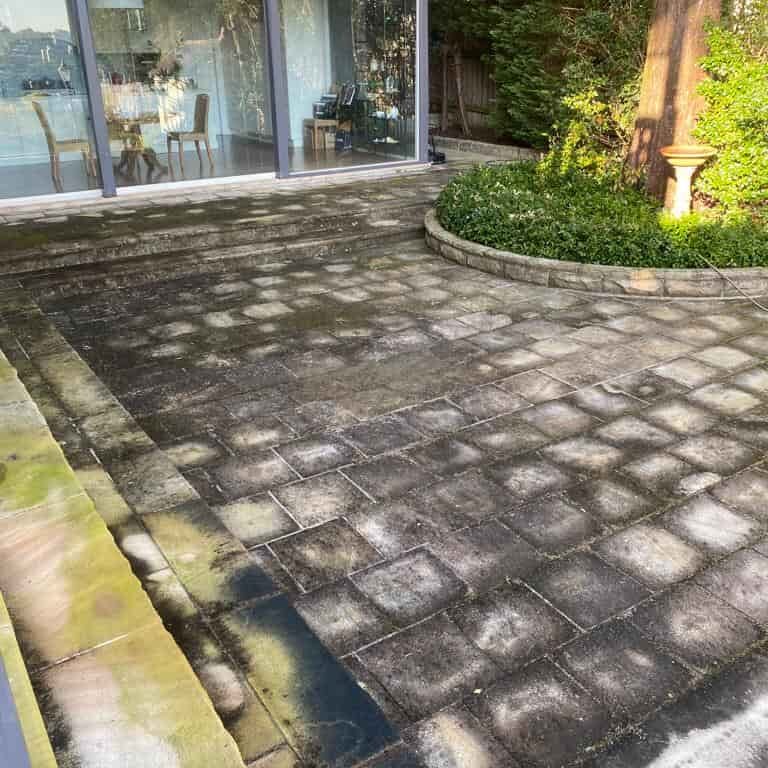

Property-Specific Factors
Several factors influence how frequently your property needs pressure washing:
Proximity to the Ocean: Properties closer to the harbour or coast require more frequent cleaning due to increased salt exposure.
Vegetation Coverage: Homes with extensive landscaping may need more frequent cleaning due to increased organic debris and moisture retention.
Traffic Exposure: Properties near busy roads face increased pollution and may require more frequent cleaning.
Architectural Features: Complex architectural details, multiple levels, and covered areas may trap dirt and require specialised attention.
Signs That Immediate Pressure Washing is Needed
Certain warning signs indicate that immediate pressure washing is necessary to prevent permanent damage:
Visible Biological Growth: Any visible mould, mildew, algae, or lichen should be addressed immediately to prevent spread and structural damage.
Persistent Staining: Stains that don’t wash away with garden hose cleaning require professional attention before they become permanent.
Efflorescence: White salt deposits on masonry surfaces indicate moisture issues that need immediate attention.
Slippery Surface: Any exterior surface that has become slippery due to biological growth poses an immediate safety hazard.
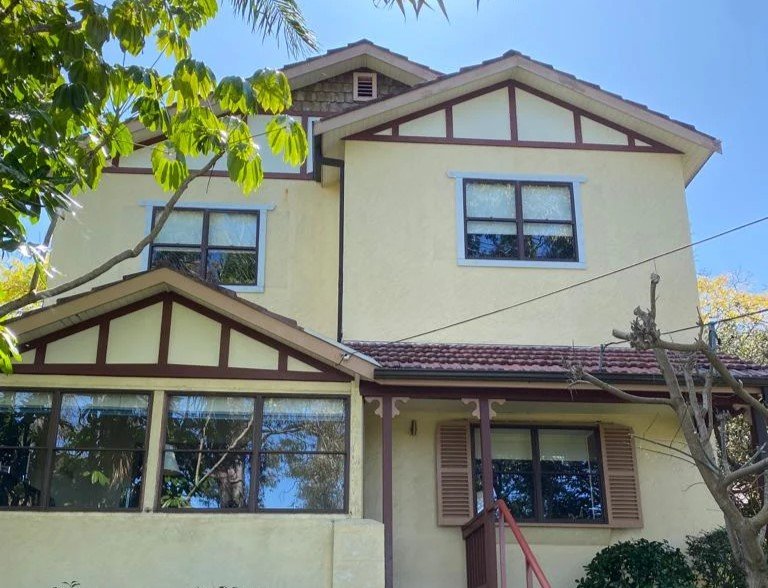
Maximising the Benefits of Professional Pressure Washing

Getting the most value from professional pressure washing services involves proper preparation, clear communication, and follow-up maintenance.
Pre-Service Preparation
Preparing your property for professional pressure washing ensures the best possible results:
Clear the Area: Remove outdoor furniture, decorations, and vehicles from areas to be cleaned.
Protect Sensitive Plants: Cover or water sensitive plants before service to protect them from cleaning solutions.
Secure Loose Items: Ensure that loose outdoor items are secured or removed to prevent damage.
Identify Problem Areas: Point out specific stains or areas of concern to ensure they receive appropriate attention.
Communication with Your Service Provider
Clear communication with your pressure washing professional ensures that your specific needs are addressed:
Discuss Surface Materials: Different materials require different approaches, so ensure your service provider understands what they’re working with.
Identify Priorities: If budget is a concern, prioritise the most visible or problematic areas first.
Establish Expectations: Understand what results are realistic for your specific situation and surfaces.
Post-Service Maintenance
Extending the benefits of professional pressure washing involves simple ongoing maintenance:
Regular Inspections: Monthly visual inspections can identify problems before they become serious.
Prompt Spot Treatment: Address spills and stains immediately to prevent permanent damage.
Maintain Drainage: Keep gutters and drainage areas clear to prevent water damage and biological growth.
Landscaping Management: Trim vegetation away from building surfaces to improve air circulation and reduce moisture retention.
Choosing the Right Pressure Washing Service in Sydney
Selecting a professional pressure washing service requires careful consideration of several factors to ensure quality results and value for money.
Essential Qualifications and Credentials
- Insurance Coverage: Ensure your chosen service carries appropriate public liability insurance and workers’ compensation coverage.
- Local Experience: Sydney’s unique climate and building materials require local knowledge and experience.
- Environmental Compliance: Choose services that understand and comply with local environmental regulations regarding wastewater disposal and chemical use.
- Safety Training: Professional services should demonstrate proper safety procedures and equipment usage.
- Service Quality Indicators
- Detailed Quotes: Reputable services provide detailed written quotes that specify exactly what work will be performed.
- Equipment Quality: Professional services use commercial-grade equipment and maintain it properly.
- Chemical Knowledge: Quality services understand which cleaning solutions are appropriate for different situations and surfaces.
- Guarantee Policy: Established services stand behind their work with appropriate guarantees.

Red Flags to Avoid
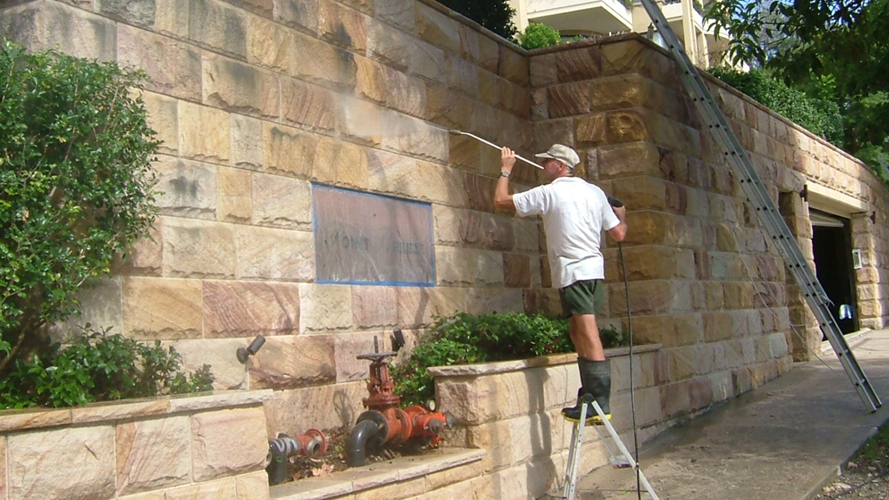
- Door-to-Door Sales: Be wary of services that appear unsolicited at your door, particularly after storms.
- Extremely Low Prices: Prices significantly below market rates often indicate inferior equipment, uninsured operators, or corner-cutting practices.
- Pressure-Only Approach: Services that rely solely on high pressure without appropriate cleaning solutions may damage surfaces or provide inadequate cleaning.
- No Fixed Address: Choose services with established local businesses rather than mobile-only operations.
The Investment Perspective: Pressure Washing as Property Protection
Understanding pressure washing as an investment rather than an expense helps Sydney homeowners make informed decisions about their property maintenance.
Return on Investment Analysis
Regular pressure washing provides measurable returns through several mechanisms:
- Prevented Repair Costs: The cost of regular pressure washing is typically 5-10% of the cost of major exterior repairs or replacement.
- Energy Savings: Clean exterior surfaces can reduce cooling costs by 10-15% during summer months.
- Extended Material Life: Regular cleaning can double or triple the life of exterior paints, sealants, and protective coatings.
- Property Value Maintenance: Well-maintained exteriors can add 5-10% to property values in Sydney’s competitive market.
Long-Term Cost Comparison
Consider the 10-year costs of different maintenance approaches:
- Reactive Maintenance: Addressing problems only after they become visible can cost 3-5 times more than preventive maintenance.
- DIY Maintenance: While initially cheaper, DIY efforts often provide inconsistent results and may miss critical problem areas.
- Professional Preventive Maintenance: Regular professional service provides the best long-term value through consistent results and early problem identification.
Environmental Considerations and Sustainability
Sydney homeowners are increasingly conscious of environmental impacts, and pressure washing practices can be aligned with sustainability goals.
Water Conservation Strategies
Professional pressure washing services can actually use less water than DIY attempts while achieving better results:
Efficient Equipment: Commercial equipment uses water more efficiently than domestic units.
Targeted Application: Professional services focus water usage on areas that need it most.
Reclaim Systems: Some services offer water reclamation systems that filter and reuse water.
Eco-Friendly Chemical Options
Modern pressure washing can be performed with environmentally responsible chemicals:
Biodegradable Solutions: Most professional cleaning solutions now biodegrade safely without harming plants or waterways.
pH-Neutral Options: Gentle cleaning solutions can be effective without causing environmental damage.
Concentrate Systems: Professional concentrates reduce packaging waste and transportation impacts.
Stormwater Protection
Proper pressure washing practices protect Sydney’s waterways:
Wastewater Capture: Professional services can capture and properly dispose of contaminated wastewater.
Chemical Selection: Choosing appropriate chemicals prevents harmful runoff into storm drains.
Timing Considerations: Scheduling cleaning during appropriate weather conditions minimises environmental impact.
Protecting Your Sydney Home Investment
Sydney’s unique climate presents ongoing challenges for homeowners, but understanding these challenges and responding with appropriate maintenance strategies can protect your investment for decades to come. Regular pressure washing is not a luxury service – it’s an essential component of responsible property ownership in Australia’s most dynamic city.
The combination of salt air, humidity, UV radiation, and seasonal weather variations creates the perfect conditions for accelerated exterior deterioration. Without proper maintenance, these forces can cause thousands of dollars in damage and significantly impact your property’s value and appeal.
Professional pressure washing services offer the expertise, equipment, and experience necessary to effectively combat Sydney’s climate challenges. By developing a regular maintenance schedule and working with qualified professionals, you can ensure that your home’s exterior surfaces remain clean, protected, and attractive year after year.


The investment in regular pressure washing pays dividends through prevented repair costs, maintained property values, improved energy efficiency, and enhanced curb appeal. Most importantly, it provides peace of mind knowing that your most significant investment is properly protected against the unique challenges of Sydney’s coastal climate.
Don’t wait until staining and damage become obvious – take proactive steps to protect your home’s exterior surfaces. Your future self will thank you for the foresight, and your property will thank you with decades of reliable performance and maintained beauty.
Ready to protect your Sydney home from weather damage? Contact SS House Washing and Pressure Washing Sydney today at 0414 556 216 for a comprehensive exterior cleaning assessment. Our experienced team understands Sydney’s unique climate challenges and can develop a customised maintenance plan that keeps your property looking its best while protecting your investment for years to come.


